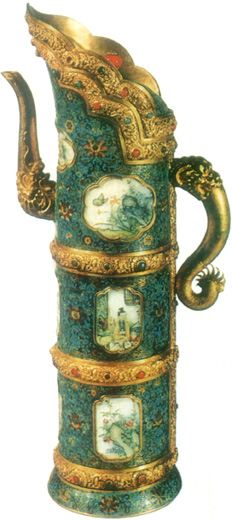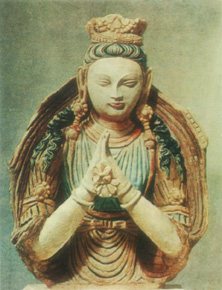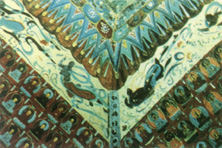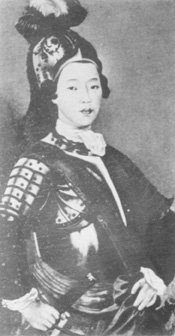 A piece of enameled "cloisonné" in the shape of tea and milk used by the Tibetan Lama(Chi-en-lung's reign of Ch'ing Dynasty 1736-1795).
A piece of enameled "cloisonné" in the shape of tea and milk used by the Tibetan Lama(Chi-en-lung's reign of Ch'ing Dynasty 1736-1795).
"However, and despite its apparent seclusion, its northern frontiers, mainly, were attacked, generally every 500 years, by nomad tribes:
Huns, Mongols and Manchurians. China expanded its territories beyond the Himalaya making conquests and expeditions to the Caspian Sea and to India where it got new elements which enriched its flora, fauna, culture and art.
China incorporated those religious and artistic trends of the West and of the neighbouring countries without losing, however, its national identity.
We shall present several examples of imports, mainly in the cultural field, which the Chinese mingled with the native substratum and gave a peculair character, diluting the foreign characteristics in their own culture."
Each truth has always, at least, another complementary truth. Thus, freedom assumes responsibility, nutrition infers food assimilation, a conclusion requires a premise, etc.
In the same way, it is unthinkable that a person or a nation may develop or improve completely isolated from the surrounding world. It is the instinct or sociability together with the strength for creativity that makes a person or a people progress. Thus, the nations improve their social, political and cultural fields through international commerce and co-operation.
There may be some countries with more talent and a better capacity for synthesis than others, but none is completely original and free of foreign influences. The Empire of the Idea has, therefore, no frontiers and pays no custom duties.
Through its millenial history, China was not an exception to this rule, even when it put an end to the relations with its neighbours for some period of time which was, obviously, short. It was precisely this anti-natural attitude that, sometimes, speeded up the re-establishment of the normal order of profitable and peaceful cooperation.
A Roman proverb says that "violent situations don't last forever". This is the lesson to be learned from our excursion through the cultural history of the Heavenly Empire in ancient times, because the modern one, from the 15th century to our days, is better known and perfectly obvious to understand.
The Western man fears the study of the Chinese culture, because the art and the thought of that country seem distant and inscrutable. Greco-Latin classicism and the categories or schemes of the Aristotelic and Thomist thought we have inherited, make it difficult to have an exact outlook on the tormented lines and colours typical of the Far East.
Nevertheless, if we grow familiar with the different esthetic trends that flourished in the ancient world, we shall recognize, fairly easily, the common inspiration and artistic motives that have always brought together and united men in their aim to create beauty.
China's civilization and destiny, in its origin, are very similar to those of Sumer, Egypt and Moenjo-daro (Indo valley). The Greek historian, Herodotus, called the land of the Pharaohs the "Gift of the (Nile) River". We could say the same about the vast Chinese plain, fertilized and ravaged by the torrential waters of the Yellow River.
The Indo River divides clearly the Far East from the Near East, although there is a great difference between the two regions. In fact, the Near East is very close to the western world and to its Greco--Roman and Jewish-Christian traditions. The Far East has totally different characteristics, because it is the opposite of Europe and of Western Asia.
Resuming the ideas of the penultimate paragraph, we know that China's vocation, along several millenia, has been and still is essentially agricultural and rural: the presence of the sea has had but a superficial influence in its history at the beginning of coeval history with the ephemeral expeditions of the eunuch Cheng Ho.
The "Middle Empire, hidden behind icy plateaux and endless deserts and steppes, fortified with the Great Wall built in 221 before Christ, bends over itself pretending to ignore the world; and in this kind of impressive isolation, it works out, with unique patience and perseverance, one of the most original cultures in history. The love of Nature and of the Universe and the love for family life are expressed, from the beginning, in its bronzes, paintings and ideas.
However, and despite its apparent seclusion, its northern frontiers, mainly, were attacked, generally every 500 years, by nomad tribes: Huns, Mongols and Manchurians. China expanded its territories beyond the Himalaya making conquests and expeditions to the Caspian Sea and to India where it got new elements which enriched its flora, fauna, culture and art.
China incorporated those religious and artistic trends of the West and of the neighbouring countries without losing, however, its national identity.
We shall present several examples of imports, mainly in the cultural field, which the Chinese mingled with the native substratum to give them a peculiar character, diluting the foreign characteristics in their own culture.
Apart from the possible origin of the pre-historical horizons of Yang Shao and Lung Shan in the Iran plateau, we know that the Han dynasty (206 B. C. - 221 A. C.) absorbed the Horde region in Southern Mongolia from where it brought zoomorphic forms and geometrically designed decorative effects to its painting and sculptures. It is the beginning of the famous Silk Road which was, for centuries, the greatest trade road between the Far East and the West.
Even by sea, China is bound up with Europe. During their captivity in Babylon, the Jews scattered themselves in China and Korea, as it is evident in the stones with the David star and the clearly sapiential inspiration of the classic book Tou Tak-King ascribed to Lao-tsé. In 166, an embassy of Marcus Aurelius Antoninus (An-tun in Chinese) arrived, via the Red Sea and the Indian Ocean, to the northeast of Annam, a part of the Chinese Empire and from there, by land, maybe at the court of Emperor Huan to whom they offered ivory, rhinoceros horns and turtle shells, which were not the products of the Roman Empire. We have proofs that, before this expedition, the Greeks knew already the port of Cattigara in the northeastern coast of Annam, which could be reached by the south of India.
The turbulent and chaotic period of the Six Dynasties (221-617) marks the introduction of Buddhism in China, which gives a new direction to the spirit and to the art of this great nation.
In the sculptures in the caves of Touen-Houang (366 B. C.), Yung-Kang, T'ien-Lung-Shan and Lung Meng, in northern China, we discover decorative elements typical of Central Asia, acanthus leaves and bushes and sketches of the capitals, clearly Hellenistic, and also Indian motives of that epoch. In the statues of Buddha, we can see the evolution from the Greek style of Gandhara to the Indian one. In the numerous frescos in those caves - those of Touen-Houang alone have 96 caves and niches - there is a rich collection of Indian legends and folklore.
Buddhism laid the foundations for a sacred architecture whose model lasted during the following dynasties until nowadays. Besides the rupestrian temples imported from India, there arose the pagodas or funerary monuments in memory of a King, which show a clear Indian-Buddhistic influence, too. Like the stupa in India, whose origins vanish in pre-history, the Chinese pagoda obeys to a cosmological symbolism and its central column represents the axis of the world or the union of the earth with the sky.
By the way, the Chinese and Indian myths have a common origin, around the year 820 B. C., but outside China. The astrological myths appear in the following centuries. During the Lao-tsé epoch (he was born probably in 604 B. C.) new legends spread and a gap arose until the time of the Contestant States (500--100 B. C.) when new impulses and emotions favoured the mythological creation. After Lao-tsé, the myth existed in China sporadically; however, the philosophers of the Sung Dynasty and the victory of the Muslim Arabs over the Tang army in the Talas River (Western Turkstan) in 751, had put an end to the myth in China. It is difficult to define clearly which Chinese legends have their origin in India. There is no doubt about the legend of the dragon (the cult of naga, water snake) and that of the swastika (the letter ten thousand in Sanskrit).
The internal homogeneity and perseverance were kept in the Buddhist art and they overcame the local differences and metamorphosis and that is evident in the religious symbols such as the lotus flower and the several mudras or positions of Buddha's hands. Buddhism adjusted and transformed the cultures where it had been introduced spreading through the trade routes of those days.
The Kushan or Gupta empire, formed by nomad tribes from Kansu, in northeast India-one of the five Indian provinces that Alexander Magnus conquered in this sub-continent, spread the Buddha image found in Gandhara and Mathura nowadays. It was the Wei Dynasty, one of the five already mentioned and probably founded by the To-pa Turks, that introduced the Buddhist art in northern China; it later passed to Korea and Japan.
 Bust of a goddess, probably of a Budhisava worshipping in a gandhara attire and hair style. (source: cave of Naksatra, Chinese Turkistan, Museum für Völkerkunde, Berlin).
Bust of a goddess, probably of a Budhisava worshipping in a gandhara attire and hair style. (source: cave of Naksatra, Chinese Turkistan, Museum für Völkerkunde, Berlin).
 "Dancing girls Apsara"(cave 379 from the grottoes of Touen-Houang-366 A. D.)
"Dancing girls Apsara"(cave 379 from the grottoes of Touen-Houang-366 A. D.)
The first stupa monuments were erected by Emperor Ashoka of the Indian Dynasty Maurya (327-187 B. C.) who came to power after the army of Alexander of Macedonia left India. The colossal columns with the "Doctrine Wheel" of Buddha and former symbol of the sun, spread by Ashoka throughout his empire, were built according to an Achaemenidian (Mede-Persian) model from Iran. We can also find the Hellenistic influence in the vividness of the animal bodies (elephants, horses, lions, oxes). The Gandhara art is almost exclusively inspired by the foreign models of the Classic Antiquity. In Beram, near Kabul, there are artifacts of the 2nd and 3rd centuries with Hellenistic, Egyptian and Syrian features.
The art centres, Mathura and Amaravati, introduced some changes in Buddhism and brought the art of that religion to perfection. But the monotheistic Islam that arrived in China between 618 and 626 (Canton, Yangchow and Ch'uan-chou or Zayton) and the fall of Magadha in 1200, under that same religion, extinguished Buddhism in India. In 226, the merchant Ts'in-lun of the Eastern Roman Empire arrived in Tonking. The Mayor, Wu Miao, sent him to the Emperor Wu in Sun Ch'uan. The jasmin cultivation, with which odoriferous tea is made, was introduced in Canton by the Arabs and the Persians in the second half of the 3rd century.
Under the Tang Dynasty (618-906 of our era), China acquires an ecumenic dimension, becomes almost international and, as we have already mentioned, broadens out its frontiers up to India and the Caspian Sea. At that time there were Chinese women in Persia and in Egypt.
In Tchang-An (Si-An), the capital, Taoism, Confucianism, Buddhism, Manichaeism, Nestorian Christianism and, a little later, Islamism developed simultaneously. The famous Sino-Syrian monument of Si-ngan-fu was discovered by the Portuguese Jesuit, Father Manuel Dias (S. J.). We suppose that the stele was buried some time after the edict of the religious persecution on 30th of September 845. The stele was erected by the Nestorian Zazbozed, a secular clergyman born in the city of Balk, in Turkstan, during the annual meeting in the winter of 780-781, the second year of the Kien-Chung period (781) of the T'ang Dynasty, "when the year was in Tso-yo, on the seventh day of the first month, which was a Sunday". In the top of the gravestone there is a cross with nine characters encarved in three rows which says: "A memorial of the noble law of Tá-Tsin in the Empire of the Middle". According to the text, Alopen arrived at Si-ngan-fu in 635, from Ta-tsin, probably in Persia. The Emperor Tai-Tsong sent his minister Fang Huang-ling to welcome him and to escort him to the court. After being convinced of the truth of the Christian religion (heresy of Nestorius, patriarch of Constantinople) that Chinese minister favoured its diffusion and, by order of the same emperor, one Nestorian monastery was built in 638. Others were erected during the following reign of Emperor Kao-Tsong (650-638) and Alopen was promoted to High Spiritual Lord, Protector of the Empire. The Christian stele of Si-ngan-fu has an engraved inscription of 1.780 characters. Besides, at the bottom, there is a series of dates in Syriac language in foreign characters. It presents a summary of Catholicism and describes the history of Nestorianism in China since 635 until the first half of the 9th century.
The painters Chou Fang and Chang-Hsuan were ordered by a Tang emperor to paint pictures of the people and the topography of Prom or Hrom (Rome) according to the descriptions of the travellers who had visited it. Unfortunately those pictures, mentioned by the historians of those times, were lost.
In 640, an ambassador of Byzantium offered some artifacts of red and green glass to Emperor Tai--Tsong who thanked him for the gifts and offered him silk clothes.
During this dynasty, 100.000 foreigners were living in Canton. In Ch'ang-An (the capital) there were 4 temples of Zoroaster and 2 Nestorian churches. Lo-Yang was the intellectual capital of China and had one million inhabitants. After the Arab invasion of Persia, members of the royal Sassanid family and many Persian and Mede traders settled in Ch'ang-An where the Sassanid silver objects were highly appreciated.
The Tang Dynasty marks the Golden Age in the history of China, but its two capitals, Lo-Yang and Ch'ang-An, were plundered several times and nothing of that splendour remains. Only the Todai-Ji temple in Nara, Japan, built by the Chinese in 759, gives an idea of the harmonious and solemn architecture of those days. We know that the ancient Japanese capital, Nara, was erected according to the model of Ch'ang-An with the outside shape of a colossal madala.
It is impossible to imagine the pomp, the wealth and the hedonism of that era of high civilization in China. The men's clothes were as luxurious as the women's: long silk gowns, swords and belts incrusted with ivory, cristal, lapis lazuli, jade and gold. Turkish clothes were fashionable even for the royal family; Burmese music was popular, girls from Sri-Lanka served strong wines and black and Malay slaves crowded the courtyards and other court rooms. Nevertheless, the Ughurs and other foreigners were not allowed either to wear Chinese clothes or to marry people of the Han race. Horse-polo, brought from Persia, was the favourite sport of the noblemen and courtiers, including the famous favourite Yang Kuei-Fei.
The Japanese temple of Shosoin has more than 3.000 Chinese objects of this period which belonged to the Japanese Emperor Shomu (deceased in 756) coeval of the Chinese Emperor Hsuang-tsung.
Despite the extraordinary receptivity of the T'ang emperors to the foreign human values, the Heavenly Empire, with its strict system of Confucianism that permeated everything, respected the traditions of its ancestors and did not let China, as a whole, lose its identity. At the end of the dynasty, besides the already mentioned external calamities, Buddhism was severely persecuted between 843 and 845.
After the Sung dynasty came to power in 960 with the help of General Tchao K'uang-yin, the Sung emperors (960-269) decided to reunite China and restore its basic characteristics. The nation didn't wish to become greater at the expenses of its neighbours but tried to restore the wealth and values of the past. And it was in this sense that it looked for the enlightment and strength for a new cultural growth.
This was the great period of intellectuals, philosophers, poets and painters. Then, a high culture, a profound mysticism and an exquisite art full of spirituality prospered. Even the Emperor Houei-Tsong himself enjoyed discussing aesthetic and philosophical problems with the members of the Thou Houa Yuan.
For almost two centuries, the Sung emperors kept China united. However, in 1126, the Tartars invaded the north and the Sung emperor confined his sovereignty to the south and moved the capital from K'ai-Fong to Hangdzou, a city rich in magnificent mansions and paradisiac gardens, which Marco Polo visited and admired.
Such as the Shang Dynasty, the first historical one, had reached perfection in bronze and the Chow Dynasty in jade, the Sung Dynasty also produced the best ceramics ever made, covered by a jade coloured varnish: good taste, moderation, elegance and harmony of shapes and colours.
Nevertheless, as we have already hinted, the Buddhist pantheon was invaded by mythical gods and images from China and thus, this country became a victim of its sense for adaptation. So, the Bodhisattva Avalokitesvara, originally an Indian prince, was represented in the Sino-Japanese pictures and statues as a woman.
The Chan sect, the ancestor of the Zen sect of Japan, was born. This sect originated, among others, "the mad poet" Mou K'i, who was an excellent landscape painter, too.
During the Mongol period, the Tantric Lamaism, a mixture of the primitive Tibetan Boh animism and Indian Buddhism entered China, mainly in the north. Except for the "Palace of the Jade Island" or the Park of the North Sea (Beihai) and the exoteric temple-palace Yong He Gong, in Beijing, Lamaism left no great vestiges in the Chinese culture.
In 1300, the Buddhist art lost its strength, only the non-ritualistic and secularized sect Ch'an (Zen in Japan) had some influence which lasts until now. The Tea Ceremony (chanoy) with some Christian influences, is one of its important legacies.
The trip made by the Venezian brothers Maffeo, Nicholau, and, above all, his son Marco Polo to Khambalik (Beijing) in 1275 became well-known throughout the world. The books of this famous traveller and cosmographer, mainly Il Miglione, made China well known in Europe. However, it was João de Montecorvino (1247-1328) who founded the first Catholic mission and was the first Archbishop of Peking. He worked alone for 11 years and died when he was 81, after 34 years as a missionary. Many Chinese princes were converted to the Catholic faith and the Mongol emperor sent an embassy to the Pope. There were 7 Catholic dioceses and each one had around 30.000 members: Peking, Zaitun or Chinchen (in Fukien), Almaligh, Kaffa, Sarai, Tana and Kumuh.
The foundation of the Ming Dynasty by the ex-buddhist monk, emperor Hung-Wu (1368-1399) extinguished Catholicism. The bishops of Ihi-Balick and of Zaitun gave their life for the faith they preached (1359-1362). Today, the only vestiges of this glorious act of the Franciscans are a Latin Bible of the 12th century found by Father Couplet S. J. in a pagan's house in Changchow (Kiangau), which is now kept in the Laurenciana Library in Florence and a calyx, probably of the same period.
As everyone knows, the evangelization of coeval China was resumed only with the arrival of the Portuguese in China in 1513 and when Mathew Ricci S. J. settled in Shiu-hing (14-9-1583) and in Peking, years later. Because that is a well known fact, we shall not develop this and other posterior European influences.
Finally we shall say some words about the art of "cloisonné" highly appreciated in the West and almost forgotten in China, where it is considered inferior to artistic bronze, porcelain and jade. Besides, the intellectuals of the Middle Empire were never interested in artifacts, neither did they study them systematically. Therefore, there is little information and few documents about them.
Only during the Ching-Tai era (Ming Dynasty, 1450-1456), did "cloisonné", porcelain reach high quality. It was called, at the beginning, Fa-lang-k'an or Kuei Kuo, names which indicate a foreign origin.
This art has had, certainly in China, some predecessors such as the inlaid work in gold and silver of the years 481-221 B. C. (Contestant Reigns), the porcelain of the Han Dynasty (206 B. C. - 221 A. C.) and the T'ang and Sung Dynasties. But, there is no doubt, its special technique came from the West and it was introduced in China during the Mongol epoch (14th century) probably by the Nestorians, Franciscans and Arabs.
As a matter of fact, the book Ko Ku Yao Lum written by T'sa Ming-Chung at the beginning of the Ming Dynasty says that "cloisonné" - a name given by the French-comes from Fo-lin or Po-lin, ,a word that means Byzancium or Constantinople in Chinese. The perfection and improvement of this art occured certainly during the reign of the Manchu Emperor, K'ien Long (1736-1796).
In conclusion and to answer directly the question put in the title of this essay, we can say that China has always been open to foreign influences and ready to make good use of the best scientific, artistic and technological discoveries and to adapt them in order to fulfil their demand for human perfection. This has happened, more or less, in all epochs. Nevertheless, sometimes and mainly during the first years of the Sung and Ming Dynasties, the Heavenly Empire, due to its territorial size and ethnic complexity, falls into the "mimesis of the past" (Arnold Toynbee) like a huge boa that after having caught a gazelle needs much time to digest and absorb it for its own profit.

"Model of Beauty"one of the titles of the famous picture of princess Wo Siu, daughter of Emperor Chi-en-Lung.
The princess photographed wearing an Italian arrmour suit and a helmet crest by Brother Giuseppe Castiglione who passed through Macau before being posted to Peking(1715-1766)and whose works had a great influence in chinese painting.
Bibliography: - Chefs-d'oeuvres de l'art (III--De la Chine à l'Inde Mongole), Librairie Hachette, 1963; Beurdeley, Michel; - The Chinese Collector through the centuries, translated by Diana Imber, Fribourg, Switerzland, 1966 - In História de la Cultura Oriental, Ed. Labor, S. A., Barcelona, the article by Roger Goepper pages 329-409 about China; -Master pieces of Chinese enamel ware in the National Palace Museum, Taiwan, Taipei, - Prática da perfeição ou o livro de Lao-Tsé "Tou Tak King" translated from the Chinese by Father Joaquim A. Guerra, S. J., Macau, 1987, pages 31-35 (bibliography about the influence of the Jews in China);- Macau e a sua Diocese by Father Manuel Teixeira, vol. II, Macau, Imprensa Nacional, 1940, pages 11-24; bibliography on this last page, note 6.
*Lic. in Portuguese Literature and Philosophy (University of Lisbon), orientalist and researcher of the Portuguese history in the East and the Jesuit Mission in Asia, Governor of International Association of Historians of Asia.
start p. 37
end p.